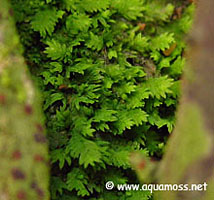
 |
|
|||||||||||||||||||||||||
|
Java Moss - The Most Common Aquatic Moss The Scientific Name of Java Moss
|
 
Mosses belong to the group of plants call Bryophytes which never produce flowers or seeds. They have a long history of evolution compared to flowering plants, with fossil record dated back 440 million years ago in the Silurian period. Most of the mosses are small, non-vascular, land plants, but some may be as large as 35cm tall and some are semi-aquatic. The mosses share a unique life cycle in having a first generation of
dominant gametophyte. The gametophyte
forms the green leafy structure we ordinarily associate with moss. Mosses
are essentially land plants, and they depend on a film of water for the
male cell (spermatozoid) to be transported to the female
cell, both which are produced on the gametophyte. When
conditions are right, the next generation, the sporophyte
or spore-bearing structure is grown. The sporophyte
is typically a capsule growing on the end of a stalk
called the seta. The sporophyte has
no chlorophyl and it grows parasitically on its gametophyte
mother. The sporophyte dries out and releases spores
that grow into a new generation of gametophytes, if they
germinate. Mosses do not have veins to transport water and food, instead, all parts of the plant are used to absord water and nutrients. Hence, mosses are found mostly at places where there are a consistent supply of water. Mosses have rhizoids instead of roots, which are branched threads. While the rhizoids can absorb water, they are mainly used to anchor the plant.
The major groups of mosses can be categorized based on the characteristics of the sporophyte which contains the spores. They can also be distinguished by their 'stem' and 'leaves' structures. Upon examining the leaves under the microscope, the shape and pattern of the leaf cells also provides distinctive characteristics.
Mosses are green plants as their leaves have large number of cells which contain chloroplast. The leaf of the moss is much different from that of higher order plants. Higher plants have leaves which are thicker in structure, with a leaf-blade (lamina) many cells thick, and the veins can transport water and other minerals. On the other hand, moss leaves have a lamina which is only one cell thick. The leaf does not have veins to transport water, although it may have a mid-rib (nerve) made of several layers of thicken or elongated cells. Some species of mosses are semi-aquatic, and are able to grow submersed in the water. These aquatic moss are of great importance to the aquarium culture, especially for the aquascaping of a planted tank.
The main use of aquatic moss is to create a nature aquarium aquascape by attaching the moss onto driftwoods or rocks. Being epiphytic, the rhizoids of the moss will anchor the plant onto the woods and rocks. These aquatic mosses can also be used to create a backdrop for your planted tank. They are also of great importance for fish breeding, where the aquatic moss is being used widely as a spawning media. It is also a good hiding place for fry, and the newly hatch fry consume the microscopic organisms that are growing on the moss. At the same time, the moss will absorb the excess waste products produced by the fry. Growing aquatic moss in the aquarium is not very difficult. Most of the moss are not very demanding in their requirements. They can tolerate lower light levels than the higher plants, and they can grow well even without the supplement of Carbon Dioxide to the aquarium. They can also grow with minumum nutrients. However, with proper lightings (about 2 watt/gallon), CO2 supplement, and some macro-nurtients and micro-nutrients, one would really be able to see the true beauty of these aquatic mosses in the aquarium.
Last update: Sep 2006 |
||||||||||||||||||||||||
Copyright © 2005. http://www.aquamoss.net
- Information about the cultivation of the different Aquatic Moss, Aquarium
Moss, Java Moss, and Christmas Moss.
|